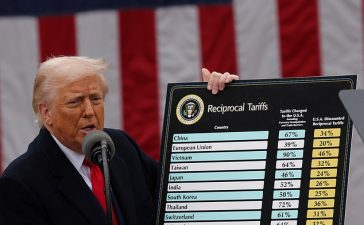This article is an on-site version of our Unhedged newsletter. Sign up here to get the newsletter sent straight to your inbox every weekday
Good morning. Spotify laid off 17 per cent of its workers yesterday, and the stock went up 7 per cent. The tech dismissal spree ain’t over. The wonder is that Spotify held out longer than bigger peers such as Microsoft or Meta. Could they all start rehiring if interest rates fall? Email us: robert.armstrong@ft.com and ethan.wu@ft.com.
The unshakeable jobs market
US employment data for November land on Friday, and they will be of even more interest than usual. For the past six months or so, the economy has produced about 200,000 new jobs a month with remarkable regularity. Yes, this is down from the job bonanza of the post-pandemic recovery, but 200,000 would be a good month in the pre-pandemic era.

Similarly, initial weekly jobless claims are moving sideways at a bit over 200,000. Both job openings and the quits rate are in a declining trend, but the pattern is not totally unlike the pattern in job creation. Quits are at pre-pandemic levels, openings remain elevated and the rate of decline has been slow recently:
What is notable about the steadiness of the job market is that signs of a pretty significant economic slowdown — not to say a recession — are accumulating quickly elsewhere. Gross domestic product growth topped 5 per cent in the third quarter; it’s trending towards 1.2 per cent now, according to the Atlanta Federal Reserve. There is visible weakness, for example, in housing starts, manufacturing surveys, retailers’ outlooks and consumer delinquencies.
The question is whether the combination of a broad slowing in the economy and job market resilience can persist: must job creation join the parade of weakening indicators? The question is important because it is consumption that is keeping the economy growing, and the labour market and consumption are closely linked.
I put the question to Don Rissmiller, economist at Strategas, and he said he sees the current situation as unstable. “In a more standard environment you would have seen firings [sharply rising jobless claims] by now . . . the fact that jobless claims are in the low 200,000s is not consistent with a downturn. There are a lot of leading indicators that are signalling trouble but the labour market is holding together.”
The best explanation, Rissmiller thinks, for the non-standard relationship between employment and the leading indicators is continued labour hoarding. Employers are still worried that if they let people go, they will not be able to get them back when and if they need them again. But once unemployment starts rising, he notes, it tends to rise “a bunch”; it’s very non-linear. It may require some sort of trigger or shock to start this process.
Bernard Yaros, lead US economist at Oxford Economics, agrees that labour hoarding may explain the fact that employment is not following other indicators. He notes, however, that some cracks are showing. Diffusion of employment — the number of industries that are adding jobs — is on the decline. Yet it might be good for the inflation fight if job gains fell to something closer to 100,000 a month to ensure that service sector inflation and wage inflation continue to cool. “The Fed can’t say it, but this is what they want to see,” he says.
Bitcoin is back
“One idea I’ve been contemplating is that bitcoin may be the key to extending western civilisation,” mused the chief executive of Coinbase, a cryptocurrency exchange whose market cap has tripled this year, over the weekend. Welcome to the crypto bull market, part III.
Bitcoin passed $40,000 yesterday and has risen 55 per cent since October, with the rest of the crypto universe rallying in sympathy. Ethereum, dogecoin, solana, cardano — all up double digits. Even Binance coin, whose progenitor is paying more in money laundering fees than Coinbase has ever earned in public profits, is up a bit.
The backdrop is rate cut expectations and an uptick in liquidity, some combination of which is behind moves in other risk assets, too. Rate cut euphoria creating a risk rally is not surprising, and we’ve discussed it several times lately. But for those who might’ve forgotten, bitcoin’s massive bounce serves as a reminder of crypto’s upside volatility.
This has two sources. First, as Katie Martin has written, bitcoin is possibly the most speculative asset of all time, a sort of flypaper for hypothetical use cases. So the rates and liquidity regime — the price and quantity of money available to speculate — matters a lot. Though the once-dominant “inflation hedge” theory of bitcoin has been rubbished by recent experience, that’s no problem. Ideas like bitcoin mining as a tool for balancing electricity grid loads are still kicking around.
Second, what gets people to buy bitcoin is rising prices. As researchers at the Bank for International Settlements have documented, price action generates buzz, which encourages people to download trading apps and buy crypto. Trend-chasing happens in all markets, but crypto is an extreme case. One unique feature of crypto rallies is that tons of retail investors pay for overpriced futures to take a levered long position. That’s how you get crypto’s spectacular collapses: prices decline, margins get called, longs get liquidated, prices decline more, and so on.
It’s a familiar story, and every time it happens, crypto’s boosters try to frame price action as evidence of institutional adoption. The angle this time is BlackRock’s forthcoming bitcoin spot ETF. Applications for such a fund have been held up at the SEC for years, but signs of imminent approval have fed speculation of a coming wave of crypto fund products backed by mainstream asset managers. One bitcoin influencer predicts “one of the most insane marketing blitzes in financial markets history as these large firms compete for billions in AUM”.
That’s possible. The question, though, is what it means for bitcoin’s prospects as a mainstream buy-and-hold investment. On this count, we are sceptical. Crypto spot ETFs show that asset managers like collecting easy fee revenue from retail investors; they don’t create a new crypto use case. Nor do they represent “institutional adoption” properly understood; BlackRock is not using bitcoin for corporate treasury management.
In other words, doing your speculation in a cushy, idiot-proofed, SEC-approved ETF will protect you from hacks and losing your password, but won’t protect you from bitcoin itself. Three in four retail investors lost money in the last boom-bust, the BIS says. Why would this time be any different? (Ethan Wu)
One good read
More on economists’ inequality debate.
FT Unhedged podcast

Can’t get enough of Unhedged? Listen to our new podcast, hosted by Ethan Wu and Katie Martin, for a 15-minute dive into the latest markets news and financial headlines, twice a week. Catch up on past editions of the newsletter here.









